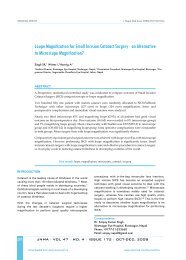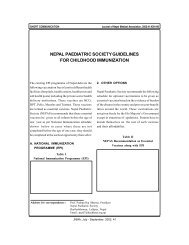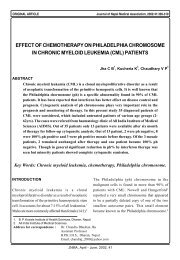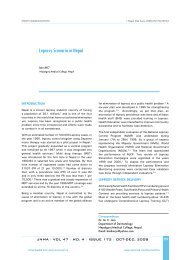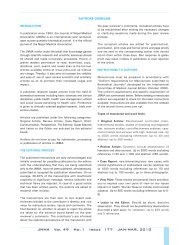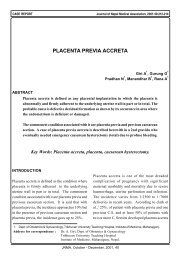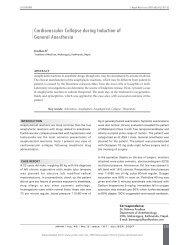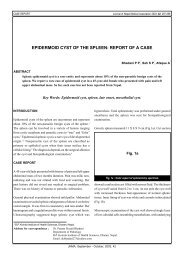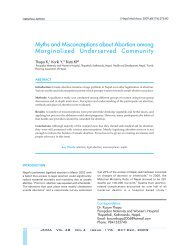Organophosphorus Poisoning - Journal of Nepal Medical Association
Organophosphorus Poisoning - Journal of Nepal Medical Association
Organophosphorus Poisoning - Journal of Nepal Medical Association
Create successful ePaper yourself
Turn your PDF publications into a flip-book with our unique Google optimized e-Paper software.
Paudyal. <strong>Organophosphorus</strong> <strong>Poisoning</strong><br />
systems, the signs and symptoms involve various organ<br />
systems. Depending on the severity <strong>of</strong> the exposure,<br />
the spectrum <strong>of</strong> the clinical presentation varies: the<br />
signs and symptoms may be mild, moderate or severe.<br />
On the basis <strong>of</strong> the receptor stimulation, the acute<br />
manifestations can be broadly divided into muscarinic,<br />
nicotinic, and central nervous system (CNS) effects. The<br />
important practical significance <strong>of</strong> this classification is<br />
that atropine only blocks muscarinic effects whereas<br />
oximes reverse both the nicotinic and muscarinic effects<br />
by reactivating AChE at both receptor sites because <strong>of</strong><br />
their ability to reactivate inhibited AChE regardless <strong>of</strong><br />
receptor type.<br />
Excess ACh in muscarinic receptors lead to increased<br />
bronchial secretions, excessive sweating, salivation,<br />
lacrimation, miosis, bronchospasm, abdominal cramps,<br />
vomiting, involuntary passage <strong>of</strong> stool and urine. Cardiac<br />
manifestations comprise bradycardia, hypotension and<br />
QT prolongation with development <strong>of</strong> various types<br />
<strong>of</strong> arrythmias. 22 Various mnemonics have been used<br />
to describe the muscarinic signs <strong>of</strong> OP poisoning:<br />
DUMBELS (diarrhoea, urination, miosis, bronchospasm,<br />
emesis, lacrimation, and salivation) and SLUDGE<br />
(salivation, lacrimation, urine incontinence, diarrhoea,<br />
gastrointestinal cramps and emesis) are commonly used<br />
ones. Stimulation <strong>of</strong> the nicotinic receptors at muscle<br />
end plate results in twitching, fasciculation, muscle<br />
weakness and flaccid paralysis; whereas stimulation<br />
<strong>of</strong> sympathetic ganglia leads to hypertension and<br />
tachycardia. Heart rate and blood pressure can be<br />
potentially misleading findings as increase or decrease<br />
can occur in both vital signs. CNS manifestations<br />
include headache, dizziness, tremor, restlessness,<br />
anxiety, confusion, convulsion and coma. Patients can<br />
also develop pancreatitis, hypo or hyperglycaemia and<br />
acute renal failure during this phase.<br />
The time <strong>of</strong> death after a single acute exposure may<br />
range from less than five minutes to nearly 24 hours<br />
depending upon the dose, route <strong>of</strong> administration,<br />
agent and availability <strong>of</strong> treatment. 23 Respiratory failure<br />
and hypotension are the main causes <strong>of</strong> death in acute<br />
stage. Delay in discovery and transport, insufficient<br />
respiratory management, aspiration pneumonia and<br />
sepsis are common causes <strong>of</strong> death. 25 Prognosis in<br />
acute poisoning may depend upon many factors like<br />
dose and toxicity <strong>of</strong> the ingested OP (e.g., neurotoxicity<br />
potential, half life, rate <strong>of</strong> ageing, pro-poison or poison),<br />
and whether dimethyl or diethyl compound. 24<br />
Intermediate syndrome<br />
The intermediate syndrome is a distinct clinical entity<br />
that usually occurs 24 to 96 hours after the ingestion<br />
<strong>of</strong> an OP compound; after an initial cholinergic crisis but<br />
before the expected onset <strong>of</strong> delayed polyneuropathy. 25<br />
Approximately 10-40% <strong>of</strong> patients treated for acute<br />
poisoning develop this illness. 26,27 This syndrome is<br />
characterized by prominent weakness <strong>of</strong> neck flexors,<br />
muscles <strong>of</strong> respiration and proximal limb muscles.<br />
Though originally seen with fenthion, dimethoate and<br />
monocrotophos, it is also seen in other OP compounds.<br />
The muscle weakness in intermediate syndrome may<br />
Table 3. Summary <strong>of</strong> clinical features and antidotes in Acute Cholinergic Crisis<br />
Receptor Locations<br />
Dangerous effects<br />
Antidote<br />
Muscarinic features Nicotinic features CNS<br />
Parasympathetic<br />
Symp Ganglia Muscarinic +NN<br />
NMJ (NM receptor)<br />
(Muscarinic receptor)<br />
(NN receptor) receptor<br />
Respiratory tract<br />
Neuromuscular Paravertebral Various parts <strong>of</strong> the<br />
Gastrointestinal tract junction (NMJ) <strong>of</strong> sympathetic brain<br />
striated muscles ganglia and<br />
Cardiovascular system<br />
Adrenal medulla<br />
Exocrine glands<br />
Urinary bladder<br />
Bronchospasm,<br />
Muscle weakness, Hypertension Restlessness<br />
Pulmonary oedema Paralysis,<br />
Tachycardia Seizures<br />
Diarrhoea, Vomiting, Respiratory failure<br />
Coma<br />
Abdominal cramps<br />
Bradycardia, Hypotension,<br />
Ventricular tachycardia<br />
Excessive secretions<br />
Urinary incontinence<br />
Atropine<br />
Oximes<br />
Respiratory and<br />
circulatory depression<br />
Oximes Oximes Atropine<br />
Diazepam<br />
254<br />
JNMA I VOL 47 I NO. 4 I ISSUE 172 I OCT-DEC, 2008<br />
Downloaded from www.jnma.com.np<br />
www.xenomed.com/forums/jnma



